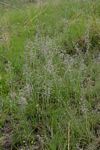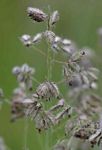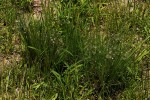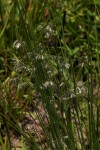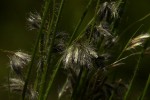| Home | > | List of families | > | Poaceae | > | Eragrostis | > | hispida |
Eragrostis hispida
Selected images: Click on each image to see a larger version and details of the record View all images (6)
Detailed records: Display species records QDS maps by: Google Maps Point records by Google Maps
Species details: Click on each item to see an explanation of that item (Note: opens a new window)
| Synonyms: |
Eragrostis bequaertii De Wild. Eragrostis blepharolepis Hack. Eragrostis sp. (Simon & Williamson 1209) of Simon |
| Common names: | Feathery love-grass (English) |
| Frequency: | |
| Status: | Native |
| Description: |
Densely caespitose perennial without rhizomes or stolons; culms up to 70 cm tall, erect, unbranched, glabrous at the nodes, the internodes softly pilose or glabrescent, eglandular; basal leaf sheaths glabrous below (others pilose or glabrescent), firm and strongly ribbed, terete, eglandular, disintegrating into a cushion of persistent fibres; ligule a line of hairs; leaf lamina 5–20(25) cm × 0.5–2(2.5) mm, filiform, densely pilose or glabrous, eglandular, glaucous to bright green.Panicle 5–7 cm long, ovate, open, the spikelets clustered at the tips of the primary branches (these bare in the lower 2/3) on short flexuous pedicels 1.5–2.5(3) mm long, the primary branches not in whorls, terminating in a slender bristle, glabrous in the axils, eglandular.Spikelets 2.5–6 × 3.5–4(5) mm, broadly oblong-ovate, lightly laterally compressed, 4–10-flowered, disarticulating from the apex downwards, the rhachilla fragile; glumes unequal, lanceolate, usually pilose but varying from glabrous to coarsely tuberculate, acute at the apex, the inferior 1.5–2.5 mm long, reaching to 3/4 the way along the adjacent lemma, the superior 2–3.2 mm long, reaching to the apex of the adjacent lemma or beyond; lemmas 2–3.3 mm long, lightly keeled, narrowly ovate-elliptic in profile, thinly membranous with conspicuous lateral nerves, diverging from the rhachilla at c. 45°, those in opposite rows not imbricate, the rhachilla visible between them, dark green with grey hairs, pubescent to pilose near the margins and sometimes also on the flanks, rarely glabrous, broadly obtuse to acute at the apex, the midnerve often slightly excurrent; palea glabrous on the flanks, the keels slender, wingless, long-ciliate with tubercle-based hairs 0.7–1.5 mm long; anthers 3, 0.8–2 mm long.Caryopsis 1–1.3 mm long, narrowly elliptic. |
| Notes: | Erect perennial grass, without rhizomes or stolons, up to 70 cm. Inflorescence an open panicle, spikelets covered in silvery hairs or bristles. |
| Derivation of specific name: | hispida: rough with stiff hairs (hispid) |
| Habitat: | A typical constituent of seepages on shallow soil overlying granite rock. Also in waterlogged soil at vleis and riverbanks. |
| Altitude range: | 900 - 2200 m |
| Flowering time: | |
| Worldwide distribution: | Sudan, Uganda, Kenya, Tanzania, Malawi, Mozambique, Zambia, Zimbabwe and Angola. |
| Malawi distribution: | N,C,S |
| Growth form(s): | |
| Endemic status: | |
| Red data list status: | |
| Insects associated with this species: | |
| Spot characters: | Display spot characters for this species |
| Literature: |
Burrows, J.E. & Willis, C.K. (eds) (2005). Plants of the Nyika Plateau Southern African Botanical Diversity Network Report No. 31 SABONET, Pretoria Page 345. Chapano, C. & Mugarisanwa, N.H. (2003). Plants of the Matobo District National Herbarium and Botanic Garden, Zimbabwe Page 15. Cope, T.A. (1999). Poaceae Flora Zambesiaca 10(2) Page 63. (Includes a picture). Jackson, G. & Wiehe, P.O. (1958). An Annotated Check List of Nyasaland Grasses The Government Printer, Zomba, Nyasaland Page 39. Mapaura, A. & Timberlake, J. (eds) (2004). A checklist of Zimbabwean vascular plants Southern African Botanical Diversity Network Report No. 33 Sabonet, Pretoria and Harare Page 104. Poilecot, P. (2007). Eragrostis species of Zimbabwe Éditions Quae,Versailles, France Pages 54 - 55. (Includes a picture). Strugnell, A.M. (2006). A Checklist of the Spermatophytes of Mount Mulanje, Malawi Scripta Botanica Belgica 34 National Botanic Garden of Belgium Page 147. |
Other sources of information about Eragrostis hispida:
Our websites:
Flora of Burundi: Eragrostis hispidaFlora of Mozambique: Eragrostis hispida
Flora of Zambia: Eragrostis hispida
Flora of Zimbabwe: Eragrostis hispida
External websites:
African Plants: A Photo Guide (Senckenberg): Eragrostis hispidaAfrican Plant Database: Eragrostis hispida
BHL (Biodiversity Heritage Library): Eragrostis hispida
EOL (Encyclopedia of Life): Eragrostis hispida
GBIF (Global Biodiversity Information Facility): Eragrostis hispida
Google: Web - Images - Scholar
iNaturalist: Eragrostis hispida
IPNI (International Plant Names Index): Eragrostis hispida
JSTOR Plant Science: Eragrostis hispida
Mansfeld World Database of Agricultural and Horticultural Crops: Eragrostis hispida
Plants of the World Online: Eragrostis hispida
Tropicos: Eragrostis hispida
Wikipedia: Eragrostis hispida
| Home | > | List of families | > | Poaceae | > | Eragrostis | > | hispida |
